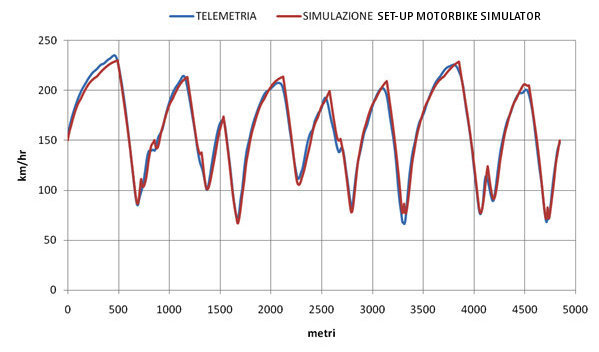|
|
|
|
|
|
|

click on image
for the presentation
|
SET-UP MOTORBIKE SIMULATOR
is a software that allows you to simulate the performance of the
motorcycle varying all the main factors influencing the
performance. It also allows you to analyze the data acquired on
the track to obtain important informations on the set-up used,
on the behavior of the tires, and on the performance of the
engine. It is therefore a fundmental tool for technicians and
engineers to prepare the motorbike before going to the track,
and to optimize the set-up in the pits, session after session. |
|
|
|
|
How it works?
|
SIMULATION |
| SET-UP MOTORBIKE SIMULATOR
through the implementation of a specific dynamic calculation and
a virtual rider calculates the performance of the motorcycle on
a determined track taking into account of all the main factors
that influence it. The software simulation variables can be
chosen or detected from each team and mechanic with extreme readiness and
are targeted to feature the motorcycle in all its aspects:
|
|
|
| MOTORBIKE
FEATURES |
Weight, wheelbase, and center gravity position of
the motorbike with rider.
Frontal area, dynamic center pressure, and coefficient
drag. |
| ENGINE
POWER |
Power curve detected on the dyno, or directly
calculated from the software processing the acquired
data. |
| FINAL and
GEARBOX RATIOS |
Primary transmission ratio, and gearbox ratios.
Front and rear sprocket used. |
| BRAKE USE |
Front and rear braking distribution. |
|
TIRES FEATURES |
Dimensions, shape, radial and lateral stiffness.
Adherence coefficient, that can be calculated directly
from the software processing the acquired data. |
| ENGINE
BRAKE |
Through some data of the engine (displacement, n°
cylinders, stroke, compression ratio) the software can
estimate the engine brake, and to simulate its effects
on the performance. |
| TRACK
RACING LINE |
Can be calculated directly from the software
processing the acquired data, in this manner the
simulation will be performed on the specific line
traveled from your rider. |
|
|
|
|
The realism of the simulations performed by the SET-UP
MOTORBIKE SIMULATION is
verified through comparisons with the data collected by
telemetry. The graph below shows an example of calculated speed
compared through simulation (red) with that measured by
telemetry (blue), you notice the absolute consistency of the
results with deviations due exclusively to driving differences
between the real and the virtual rider in some points of the
track. |
 |
|
This consistency therefore allows to exploit SET-UP MOTORBIKE
SIMULATOR to
predict the behavior of the motorcycle and its performance as a
function of the technical choices and of the set-up which are to
be performed. This allows to identify in advance the correct
direction of fine tuning of the bike to vary of the tracks, of
the track conditions, of the physical characteristics of the
rider, etc. |
|
|
|
As you have seen among the
simulation variables there aren't the suspensions and their
adjustments. This has been done because the virtual rider would be
able to adapt his guide to the suspension setup and therefore the
comparison of performance varying the suspension setup would be of
little significance. We've therefore decided to separate the two
aspects, on the one hand to simulate the performance to optimize
balance, engine, gear ratios, brake, etc. and then use this
simulation as a basis for evaluating how the performance varies in
function of the suspension setup modifications. The
simulation variables to evaluate the effects of the suspensions
setup are: |
| CHASSIS
GEOMETRY |
Position of the front sprocket respect to the pivot
of the rear swingarm, to evaluate the effect the chain
pull.
Adjustments steering plate to evaluate steering and fork
angle. |
| FRONT
SUSPENSION |
Fork length and bottom out length.
Stiffness and preload springs.
Compression and extension damping.
Wheel weight. |
| REAR
SUSPENSION |
Kinematics geometry.
Shock length and bottom out length.
Stiffness and preload springs.
Compression and extension damping.
Wheel weight. |
Thanks to this simulation it is possible to see how the suspension
setup choices modify the loads on the front and rear wheels, and
then to see in every point of the track how change the rider's
ability to accelerate or brake with more or less effectively. |
| |
ACQUIRED
DATA ANALYSIS |
The SET-UP MOTORBIKE SIMULATOR software combines the simulation
functions with those of analysis of the acquired data, already
present in the Motorbike Analysis software, this allows to multiply
the advantages of both the aspects. As you can see in the detail by
looking at the presentation of the Motorbike Analysis software, the
calculations carried out by the software allows you to have much
more informations from the acquired data, and above all these
informations can be easily interpreted to evaluate the performance
in all its aspects. In fact, the software performs:
| TIRES ANALYSIS |
The software performs a dynamic simulation using the
acquired data, this allows to evaluate, based on the
structural characteristics of the tire, the coefficient of
adhesion that the tires provided during the examined lap,
and above all how much the grip available has been exploited
at each point of the track, both laterally (corner), both
longitudinally (traction, and braking). In this way it is
possible to have immediate informations both on the balance
of the motorbike, both on the rider's driving. |
| SLIP ANGLE
ANALYSIS UNDERSTEER-OVERSTEER |
Always through the dynamic simulation calculations, thanks
to the tire model developed in the software, it is possible
to have informations on how much the front and rear tires
slip, and therefore on the understeer or the oversteer
conditions that the rider has to face at every point of the
track. |
| TIRES
TEMPERATURE ANALYSIS |
Based on the loads calculated on the wheels, and on the
lateral and longitudinal slipping of the tires, through a
specific calculation model, the software simulates the trend
of the tire temperature at each point of the track, and in
the three areas of the tread, right side, center, and left
side. It will then be possible to see how the rider's
driving, and the setup used, influence this aspect, and
evaluate the areas of the track where the tires can
overheat, or where, on the contrary, the tread remains cold. |
| SUSPENSIONS
ANALYSIS |
The software calculates how changes the load available at
the front and rear due to the presence of the suspensions
and of the setup used. Thanks to this, it simulates the
speed that you might have under braking, cornering, and
traction, due to the different load generated by the
suspensions setup, and the related lap time. It will
therefore be easy to compare the different setups and to
understand what can be most effective for the specific
driving style of the rider. |
| ENGINE ANALYSIS |
Finally, through the data acquired in the session, the
software calculates the power curve that the engine has
developed, this allows you to immediately understand if the
engine is working correctly, by comparing the results of the
previous sessions. |
| TRACK RACING
LINE ANALYIS |
The software through the acquired data calculates the track
racing line traveled by the rider, and above all the radius
of curvature at each point of the track, this allows to
understand if the rider has had a smooth driving, or if
there are points where he presents difficulties that may
depend from an incorrect interpretation of the track, or
from setup problems. |
Thanks to these analysis it is possible to easily compare the
different laps and the different sessions to immediately understand
the advantages and disadvantages of the different setup choices,
both on the behavior of the motorbike and of the tires, both on the
rider's driving.
|
COMBINATION SIMULATION - ACQUIRED DATA ANALYSIS |
The software functionalities of simulation and of acquired data
analysis can be used separately for specific purposes, but they can
also be combined to obtain further informations.
First, the calculations on the acquired data can be used to obtain
input data for the simulation. In fact thanks to the software it is
possible to obtain from the acquired data:
| tires adherence
coefficients |
With these data it is possible to carry out a simulation
that is fully consistent with the specific behavior of the
engine and of the tires, and with the real interpretation of
the rider of the track. |
| exploitation adherence |
| engine power curve |
| track racing line
traveled |
Thanks to this it is possible to exploit the simulation to analyze
other aspects of the performance obtained on the track, such as:
| INDIVIDUATION
BEST TRACK LINE |
As you know, the track racing line has a considerable
importance on the lap time that you can get. From the
analysis of the lap times obtained by the rider during a
session it is not easy to understand if the improvement or
slowdown depends on a different line, or on the fact that he
rode better. With the simulation, on the other hand, this is
possible, therefore, thanks to the software, can be
calculated the lines of the various laps, and can be
simulated the lap time that the virtual rider is able to
obtain with the different lines calculated. It will then be
possible to show to the rider the best line that he used. |
| OPTIMIZATION
RIDER DRIVING |
Calculating from the acquired data the grip, the engine
power, and the racing line traveled by the rider, it is
possible to carry out a simulation using these data and to
compare the driving of the virtual rider with that of the
real rider, in this way it will be easy to see where the
rider can improve in driving, helping him to identify the
points on which he has to work more in the guide, or for his
characteristics, or for setup problems to be solved with the
technicians.. |
These are just some examples of how the possibility of combining
simulation and analysis of the acquired data allows to obtain a lot
of further informations. In the following document we summarize the
main utilizations of the software. |
|
|
As you have seen from
this brief description, the SET-UP MOTORBIKE SIMULATOR software is
an extremely useful tool for technicians and engineers, and riders,
to improve the motorbike, the setting, and the driving, both before
going to the track, both, session after session, and race after
race.
The software was born 10 years ago with the name Performance Track
Simulation also used by engineering specialized in the design of
racetracks to analyze the performance on new circuits and have
useful data for the approvals by the federations (FIM, DORNA, FMI,
etc.), then it became SET-UP Bike, orienting its functions to the
needs of technicians and engineers for setting up of the motorbike
on the track, and today it has become
SET-UP MOTORBIKE SIMULATOR, with further developments and functions,
optimized also thanks to the experiences accumulated in these years
with our users in the CIV, CEV, BSBK, SS, SST, etc. |
|
Purchase |
|
|
|
|
NT-PROJECT - Ferrara (Italy)
- info@ntproject.com |
tutto il
materiale contenuto nel presente sito è coperto dalle leggi sul diritto d'autore ©
2005/19 |
|